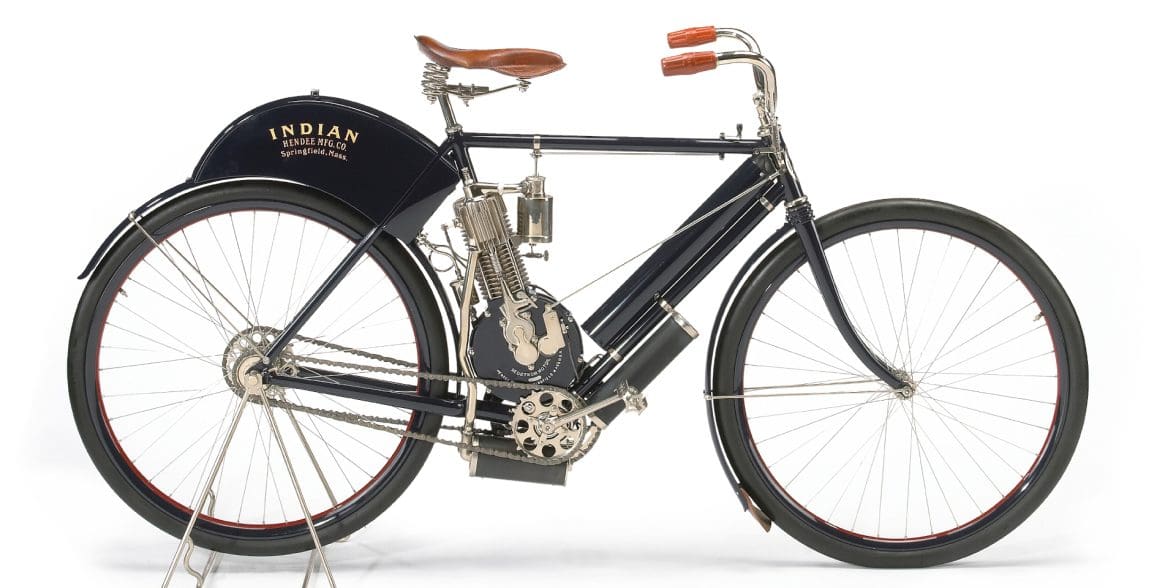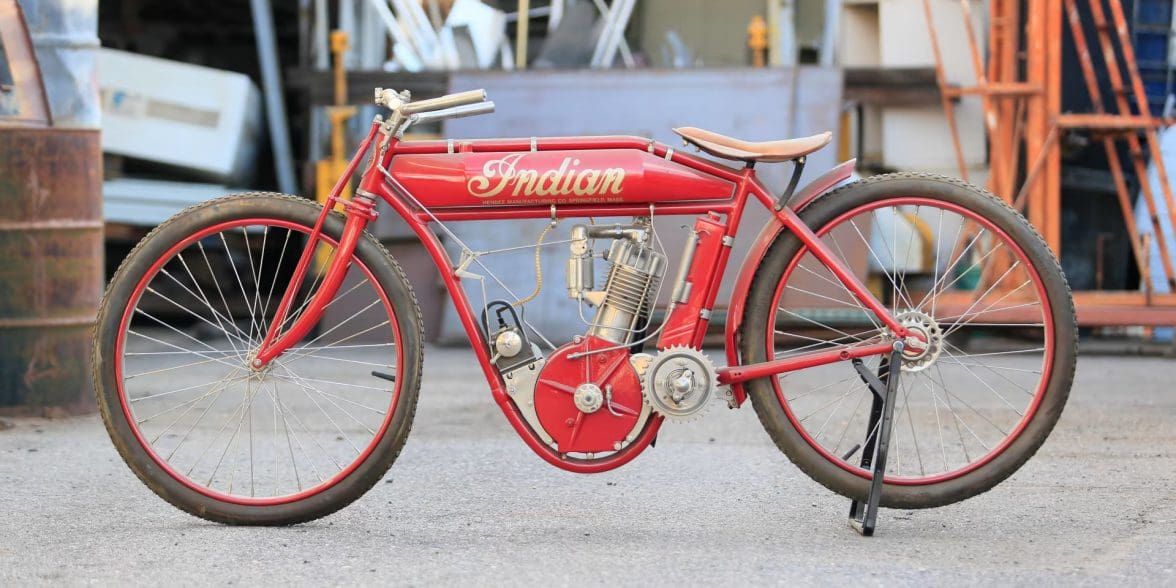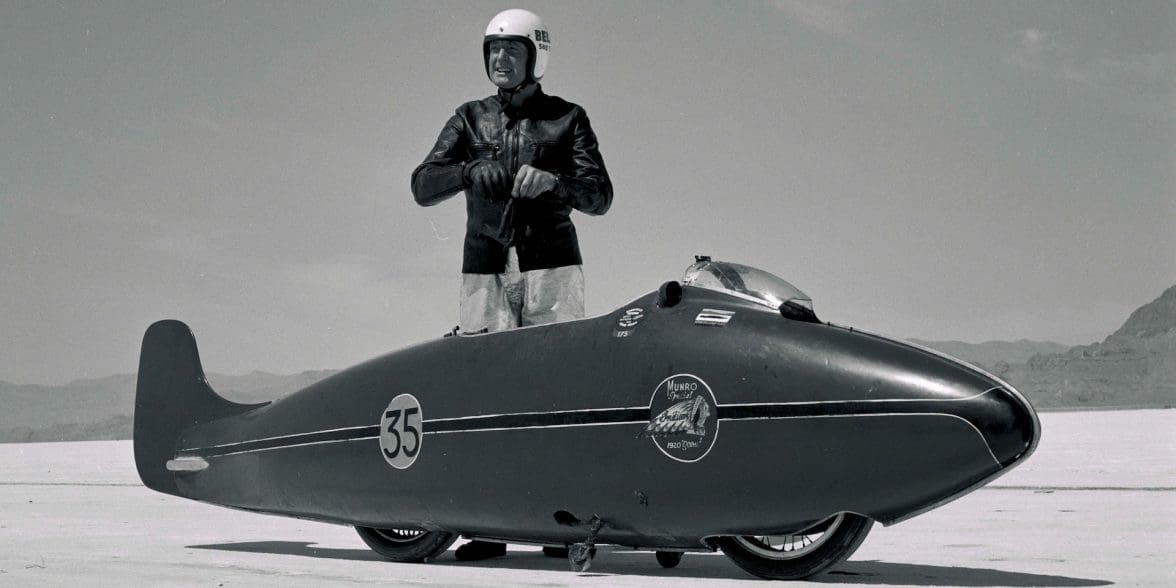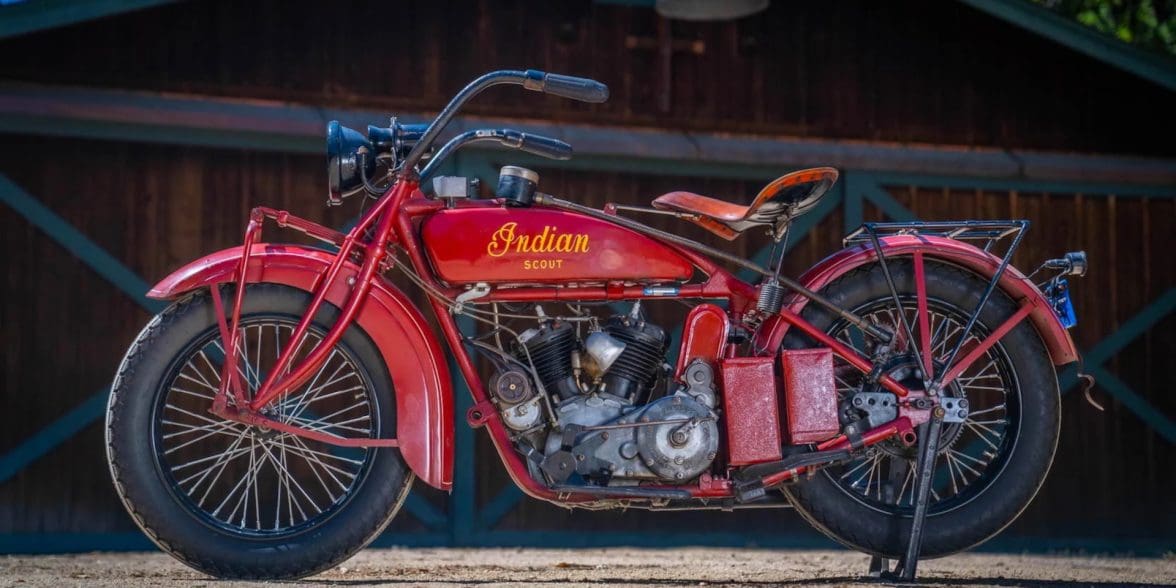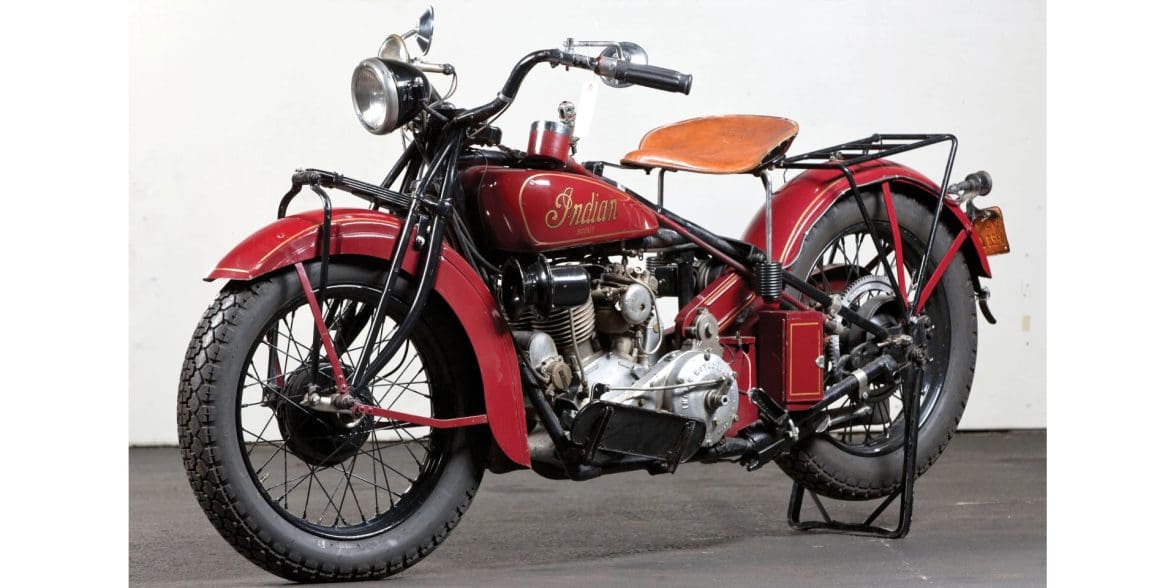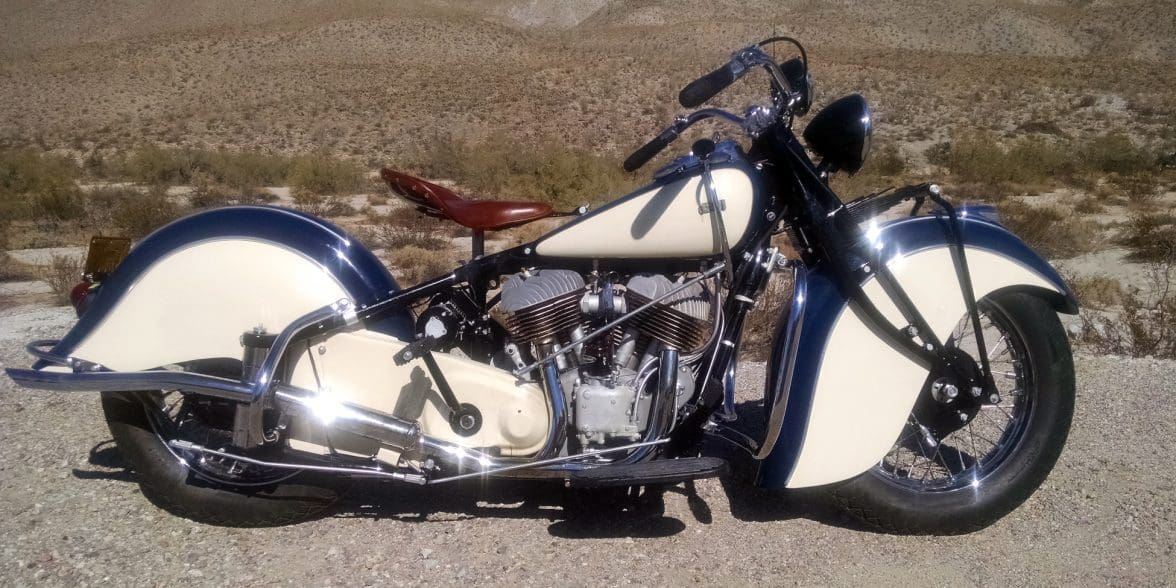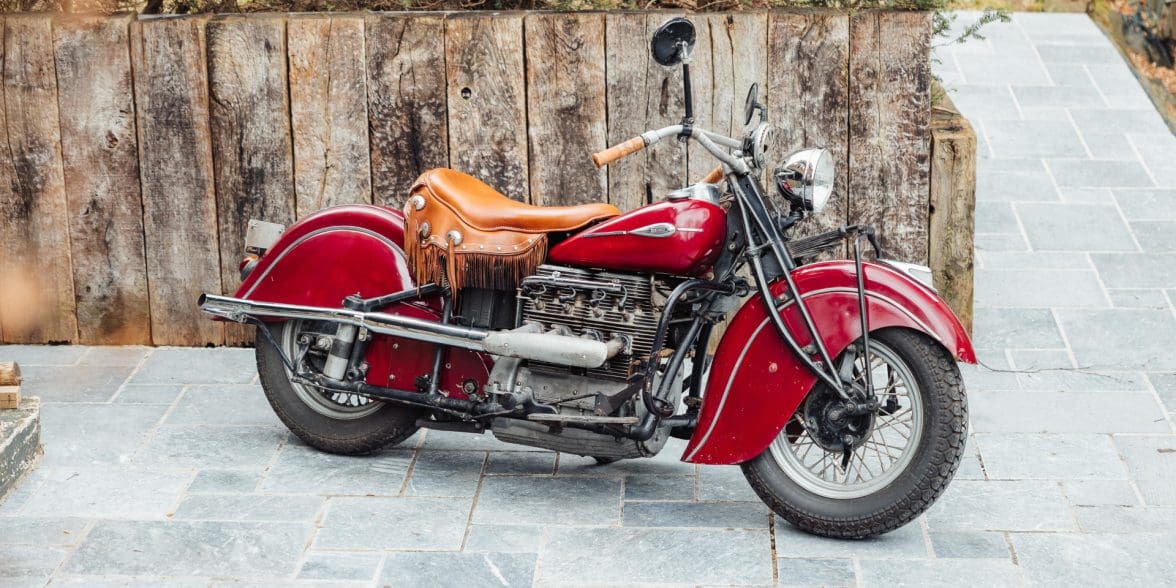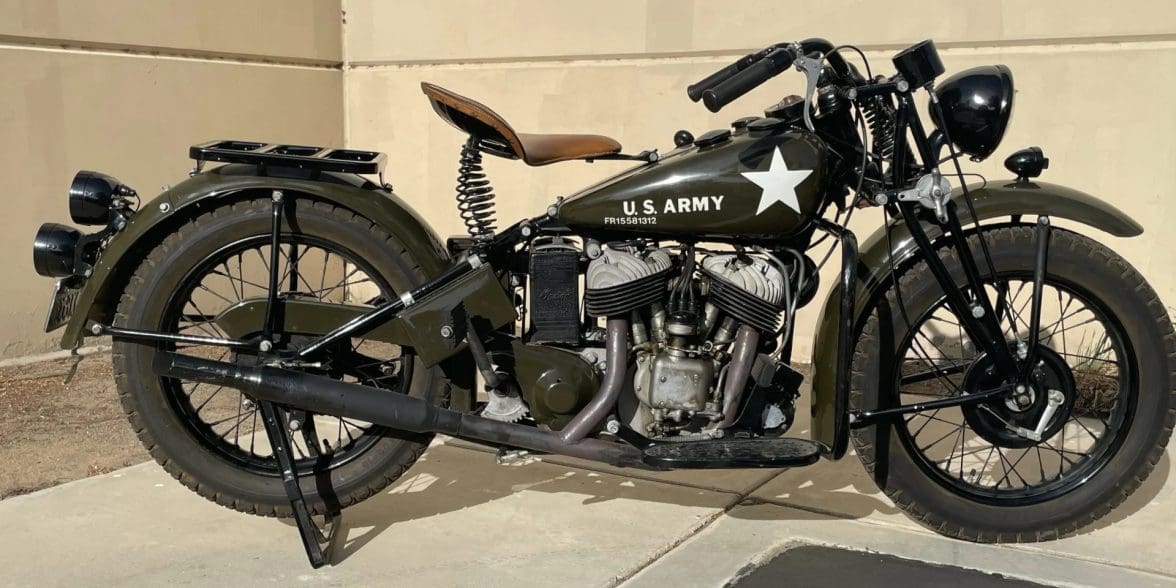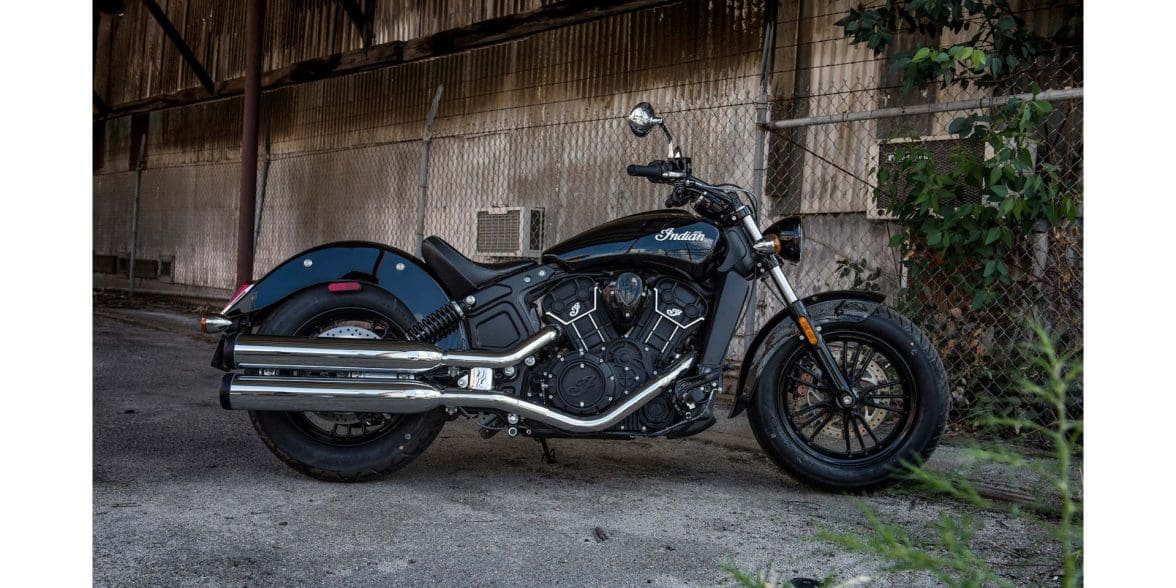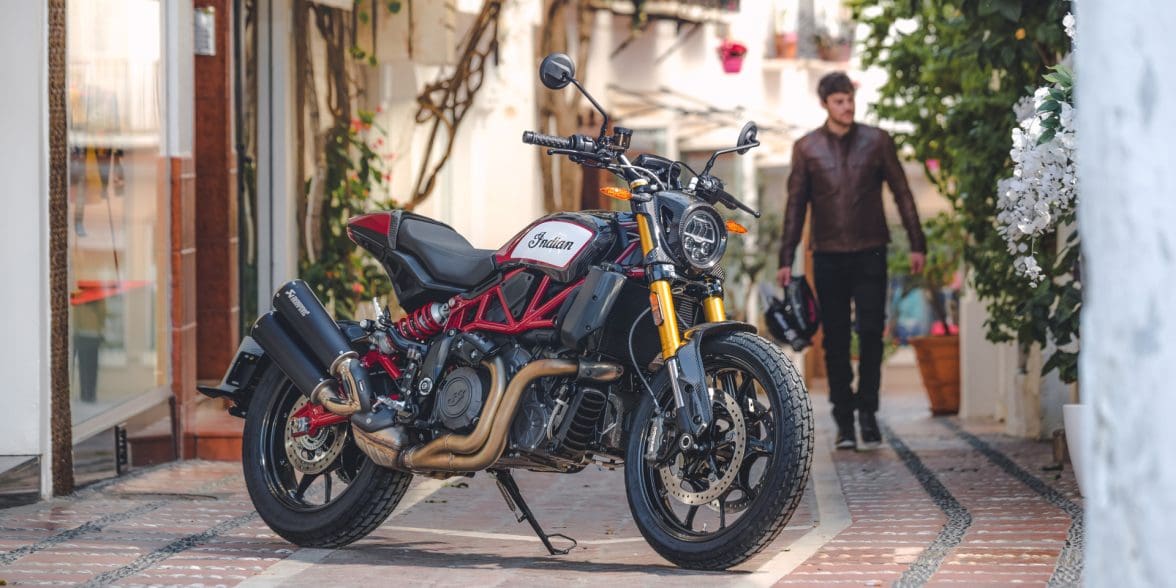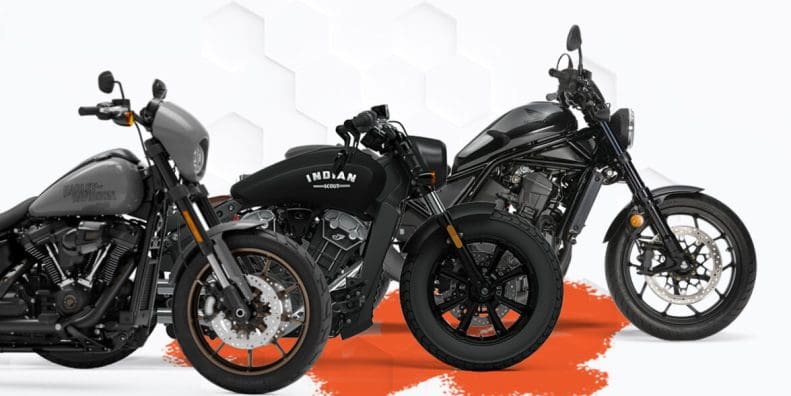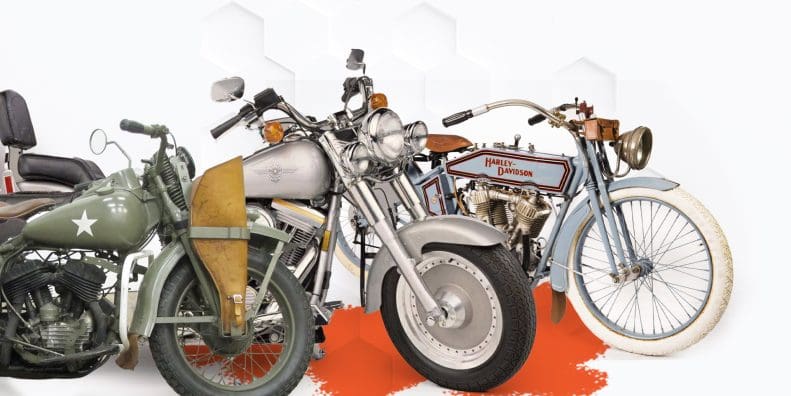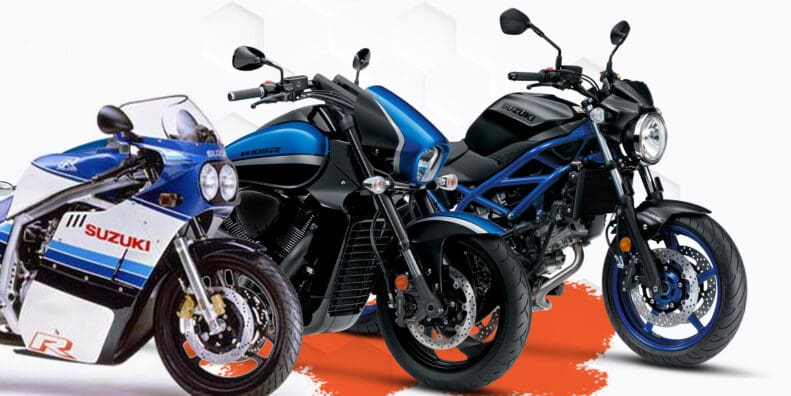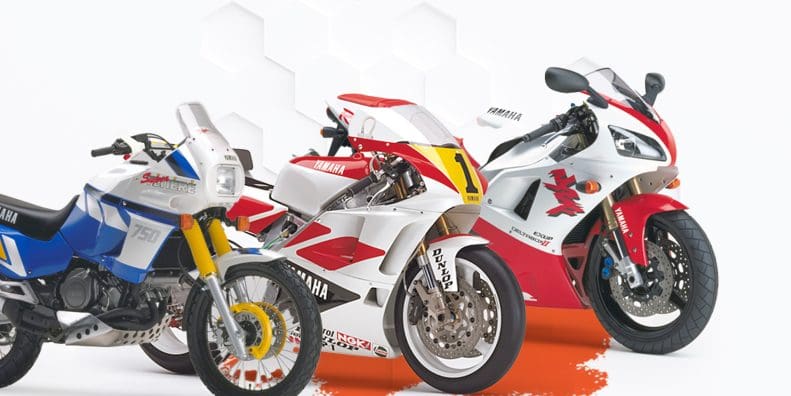The Best Indian Motorcycles Ever Made [2024 Edition]
Updated September 11, 2023 by Simon Bertram
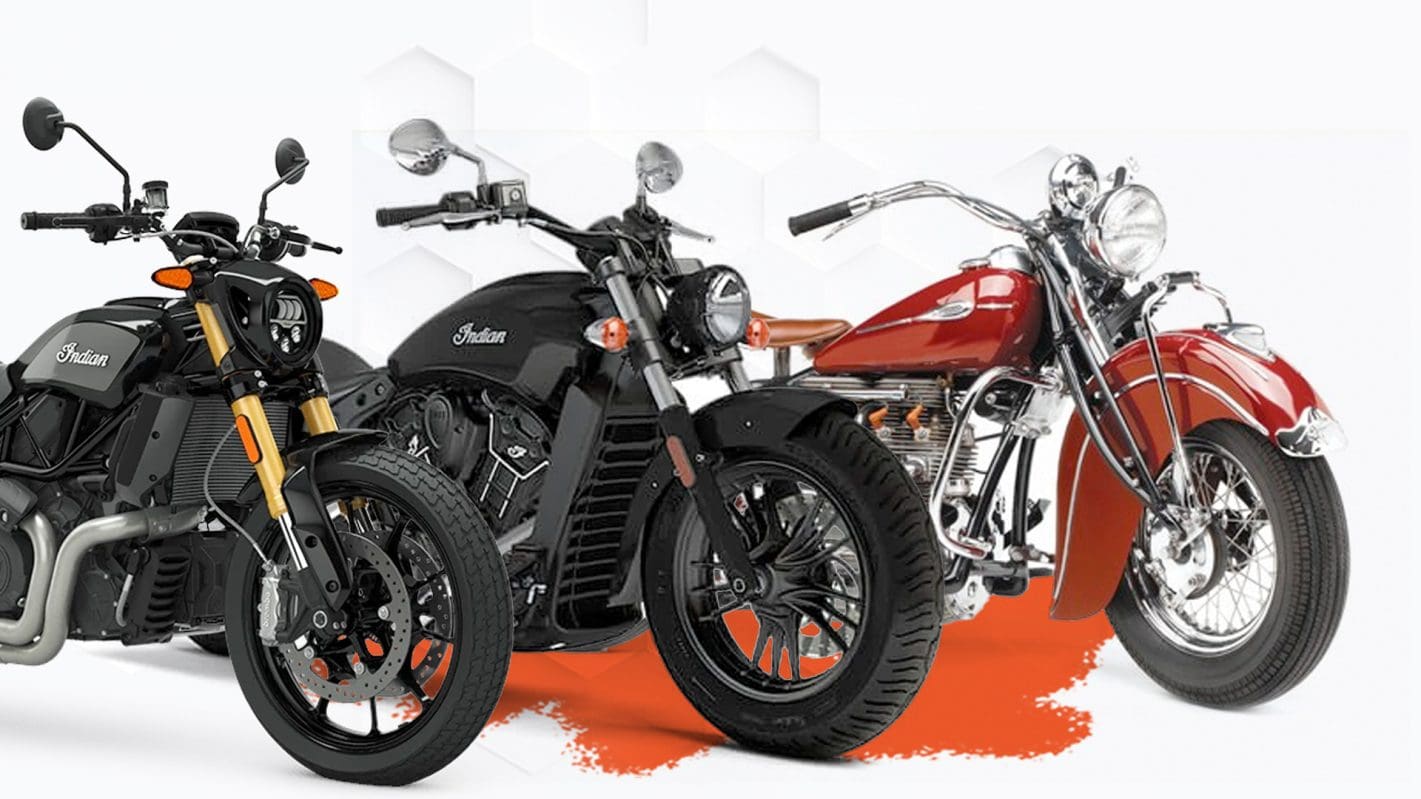
A History Filled With Fast & Beautiful Bikes
Article Quick Nav
These are the best Indian Motorcycles ever made:
In sheer technical terms, Indian Motorcycles is one of the oldest companies in the business, right up there with Harley-Davidson, Royal Enfield, and Triumph. All of those companies had a motorcycle model out on the road between 1901 and 1902, although most if not all were motorized bicycles (hence, motorcycles) with a tiny 50cc or less single.
What brought Indian to fame, however, was the fact that almost as soon as they created their own "sport" motorcycle, they took it racing, and often winning at those races. This led to widespread exposure, and by the end of the 1910s, Indian was the largest motorcycle manufacturer in the world by volume. They continued to innovate and produce some truly classic motorcycles, until the second World War occurred. The material rationing and drop in sales revenue pitched the company onto a slippery slope down to 1953, when it effectively suspended operations, although motorcycles built by other companies did sometimes license the name.
Operations resumed nearly half a century later, in 1999, and today Indian rivals Harley-Davidson for the title of "America's Motorcycle Company." We here at webBikeWorld discussed how we wanted to tackle this list, having one pre-1953 list and one post-1999 list, but in the end we decided to combine the two into the entire 122 year history. Therefore, here are what we think, in our subjective opinions, are the best 9 Indian Motorcycles ever made up until 2023.
See also: Indian Motorcycles research center
About Our Selections
The criteria for this list is not as simple as just having the Indian name on the motorcycle. To be specific about it, we only considered motorcycles that were produced between 1901 and 1953, and 1999 to the present, as viable. This means that the bikes that were released between 1953 and 1999 by other manufacturers, but bore the Indian Motorcycles name, do not qualify for this list.
There is only one very special exception to this rule in our list, due to the historical significance the bike has, although it uses a model that was made in 1920.
1901 Indian F-Head
The first motorcycle ever made by Indian
Why We Picked It:
The story of the 1901 F-Head is an interesting one, as it wasn't even supposed to be branded as Indian. Instead, the Hendee Manufacturing Company was formed in 1897 to produce bicycles, of which one was called the American Indian. That name became synonymous with the company, so in 1898 they renamed to American Indian, then quickly to just Indian Bicycles.
In 1900, Oscar Hedstrom, a genius engineer, joined Indian and designed the first fully in-house single cylinder engine, which produced 1.75 HP. What earned him the genius badge is that instead of simply attaching the engine to a bicycle like all the other companies, the Indian F-Head was the very first motorcycle to include the engine as a stressed frame member. It was also the first motorcycle with a chain final drive, instead of the leather belts or shafts that other manufacturers used.
Four total F-Heads were made, all of the prototypes, and upon seeing the marvel of the motorized bicycle with its engine "built in," investors flooded Indian with money, and soon mass production of the Indian Single, the first production model based on the F-Head, was underway.
Specifications:
Price: Unknown
Engine: 213cc (13 ci) two-stroke single
Power: 1.75 HP
Torque: Unknown
Transmission: Single Speed Chain Drive
Curb Weight: ~100 lbs
Strengths:
Never intended to be released as production models, nonetheless three of the four F-Head prototypes were eventually sold into private ownership
Was the first ever motorcycle with the engine as a stressed member.
Had an innovative chain direct drive that had the pedal chain on one side, and the motor's drive chain on the other, on two different sized sprockets
In 2006, the first F-Head prototype, serial number 1, sold at auction for $165,000 USD against a reserve of $110,000 through Gooding & Company Auctioneers
Learn More:
1910 Indian Single Model A
The first Indian with a dedicate motorcycle frame, not a modified bicycle frame
Why We Picked It:
Note: The image above is of an Indian Single Model A, but is missing its engine sprocket and two chains. Please see the linked video to the bottom of the right column to see one in action.
As the first decade of the 20th century ended, Indian had sold enough of their Indian Single motorized bicycles to be a secure and even profitable business. However, to keep customers interested, innovation and evolution were needed, and that's where the 1910 Indian Single Model A comes in.
Indians so far had been built on modified bicycle frames, meaning that the frame was oriented towards pedals first, motor second. The Model A flipped that, with a frame that was meant for the motor first, pedaling second. In essence, it was the first dedicated motorcycle frame from Indian, and even had a "clutch" system where the motor drove the pedal sprocket, which in turn spun a second drive sprocket to power the rear wheel, without moving the pedals. Only when the rider actually pedaled did the "clutch" engage, allowing them to spin the drive socket to spin the rear wheel. It was, frankly, an ingenious way of keeping all the chains to one side of the bike. On later versions that had hand-shift gears, the actual clutch was inside the pedal box area, and was one of the first spinning disc style clutches on a motorcycle.
What we assume today to be givens were new to the Model A. It had a built in fuel tank in the upper frame, had a dedicated engine frame area and attachment points, and had the pedals about where mid-mount pegs are on todays bikes. Back then, it was a revolutionary motorcycle, and it succeeded in showing that there were two ways to travel on two wheels: pedal cycle or motor cycle.
Specifications:
Price: Unknown
Engine: 461.64cc (30 ci) four-stroke single
Power: 4 HP
Torque: Unknown
Transmission: Single Speed or 3-speed hand shift
Curb Weight: ~150 lbs
Strengths:
The first Indian to feature a purpose built motorcycle frame, engineered from the ground up to hold the engine and use it as the primary power source
Multiple versions of the Model A were available, including the Model A 3 speed, Indian Twin Model A with a tiny V-twin engine and 3 speed hand shift, and the Indian Single Model A Track Racer, which was bored out slightly and had 5 HP and stiffer springs for flat track racing
Had a "clutch" system inside the pedal area that would only engage the clutch if the rider pedaled, otherwise acted as a single speed drive. In the Model A's with transmissions, the gears were located inside the pedal clutch area.
Learn More:
1920 Indian Scout Streamliner Munro Special
The World's Fastest Indian
Why We Picked It:
Even thought the record set by Burt Munro of New Zealand happened in 1967, it was still done using a highly modified 1920 Indian Scout with a dedicated body shell. The original 1920 Indian Scout was barely capable of a top speed much more than 55 MPH, but after a lifetime of tinkering, Munro had converted it so that he was able to lie down on his front over the top frame and engine, and his legs and feet would tuck down beside the rear wheel, on either side of it.
Around the frame, he built a body shell that was streamlined with the knowledge of 1960s aerodynamics, making it as slippery as possible through the air. A man of modest means, he worked the frame, fabrication, and even rebuilt the engine all on his own. The 610cc V-twin from the Scout had been bored out over the years to 850cc, then to 920cc, and finally to 950cc, all done by hand.
Munro even went so far as to fabricate his own barrels, pistons, flywheels, cams and followers. He would take stock tires and, using a kitchen knife, cut off the treads by hand to make slicks. The engine was so specialized that it needed to be completely rebuilt after every 2 or 3 speed record attempt runs.
However, in the end, in 1967 at the Bonneville Salt Flats in Utah, Munro set an under-1000cc speed record of 183.59 MPH (295.453 KPH), with a qualification one way run speed of 190.07 MPH (305.89 KPH). The unofficial but recorded and verified flying mile speed he achieved was 205.67 MPH (331.0 KPH). All three records stand to this day as the fastest under-1000cc speeds achieved by an Indian Motorcycle, as well as by a pre-war motorcycle.
Specifications:
Price: Priceless
Engine: 953cc (57.97 ci) modifiedV-twin
Power: ~100 HP
Torque: Unknown
Transmission: 3 Speed Hand-Shift Helical Drive Manual
Curb Weight: Unknown
Strengths:
Highly modified but kept the engine and base frame of a 1920 Indian Scout
All of the lightening, engine work, even tires were all modified or fabricated by Burt Munro himself
Two frames were built, one in New Zealand and one in the United States, with the engine travelling between the two frames as needed.
The engine was so highly modified from the original 610cc to a huge 950cc that it required a full rebuilt every 2 to 3 speed runs
Still holds the pre-war under-1000cc speed record to this day
Learn More:
1927 Indian Scout BGE 45
One of the best of Indian's pre-WW2 "sporty" Scout models
Why We Picked It:
Indian by the 1920s had become a massive company, at the time the world's biggest manufacturer of motorcycles by volume, and while they had been making racing bikes for flat-track racing for a while, they were still exploring the idea of a "sport motorcycle" for road use. One of these exploratory models was the absolutely gorgeous looking Indian Scout BGE 45.
Originally powered by a 36.37 ci (596cc) V-twin and called the Scout BGE 37, it was bumped up to 45 ci (745 cc) version for 1927 and was named the Scout BGE 45 to denote the new engine. In all cases, the biggest thing about the BGE was that it was very lightweight. Even with all the metal used in its fabrication, it weighed less than 320 lbs when fully ready to ride with the 45 ci engine, and under 300 lbs with the 37 ci one, which is lightweight even by today's standards. It was also a hardtail, with the seat itself on suspension instead of the rear wheel. This made it superb for track use, as well as gave it a "sporty feel," as the marketing material stated, on the road.
The Scout BGE also had one of the most advanced engines of its time, with tech such as the sidevalve intake via a single side-draft carburetor, the transmission case being bolted directly to the engine casing, and a geared primary drive inside, the only V-twin at the time to use such a primary drive.
With all these advancements, as well as the larger bore of the 1927 BGE, it produced a frankly astounding 18HP at the time, making it one of the fastest motorcycles around as well with a top speed of around 60 to 65 MPH. The 1927 model only lasted one year, to be replaced by the Scout 101 in 1928, but this big-engined beauty absolutely deserved to be on our list.
Specifications:
Price: $9,104
Engine: 745cc (45 ci) V-twin
Power: 18 HP
Torque: Unknown
Transmission: 3 Speed Hand Shift Manual
Curb Weight: 317 lbs
Strengths:
From 1920 to 1926, the Indian Scout BGE was the "sporty" version of the standard Indian Scout, as they didn't have a name for sport bikes or sport cruisers at the time
Used a 596cc V-twin for most of its life, but for 1927 it was upgraded to 745cc, giving it a bump of 3 HP to 18 total, up from 15 HP.
One of the highest-tech engines at the time, it used a single side-draft carburetor between the V, feeding a sidevalve intake/exhaust system that kept the engine relatively compact in height, allowing the Scout BGE to keep its frame low, making its center of gravity low, and it became the preferred track bike of many racers
It impressed the US Police Association so much that they commissioned Indian to make a Police Special variant that included a siren horn on the handlebar, and a rear tire guard bar.
Learn More:
1928 Indian Scout 101
Widely regarded as one of the, if not the, best pre-World War 2 Indian motorcycle
Why We Picked It:
Designed by the same man that crafted the Scout BGE, Charles Franklin, the 1928 Indian Scout 101 took all of the lessons learned from the "sport" model and made it the mainstream option. The biggest upgrade was an all new frame with more front fork rake, which gave it a longer wheelbase and lower seat height. It came standard with the 45 ci (745cc) V-twin from the Scout BGE 45, as it was the most high-tech engine they had at the time.
With the longer wheelbase, a full 57.125 inches (1,450mm), the Scout 101 was praised for its superb handling and quickly became popular with the sporting crowd, including racers, hillclimbers, and the new hobby/profession of stunt riders for "high thrills" circuses where they were used for silodrome, or "Wall of Death," demonstrations. It was a resounding sales success, but the version that so many people loved was only made for three years, from 1928 to very early 1931.
The Great Depression had started in 1929, and as sales plummeted for almost every industry, Indian Motorcycles was pushed right to razor's edge of bankruptcy. It was purchased by the DuPont family (the same DuPont family that runs the major chemical company) and to rationalize production, the expensive Scout 101 frame was discontinued, and a new frame that could be used across all of the motorcycles with some detail variations was created. This new frame was primarily built for the Chief, but the Scout 101 ceased to be, and was renamed to just the Indian Scout, with enthusiasts calling it the Scout Chief Frame.
Specifications:
Price: Uknown
Engine: 745cc (45 ci) V-twin
Power: 18 HP
Torque: Unknown
Transmission: 3 Speed Hand Shift Manual
Curb Weight: 317 lbs
Strengths:
Only lasted from 1928 to very early into 1931, as the Great Depression forced Indian Motorcycles to offer itself for sale to prevent bankruptcy. The DuPont family bought out the company, but discontinued the expensive Scout 101 frame in favor of a universal frame that could be dressed up differently to make different models
Kept the "Indian 45" V-twin its entire life, with 18 HP and a top speed of nearing 65 MPH
Considered by many to be the single greatest pre-World War 2 Indian Motorcycle
The last of the original "sport" Scouts, popular with racers, hillclimbers, stunt riders, and sport riders
Learn More:
1940 Indian Chief
While the Chief started in 1922, it was in 1940 that it became the classic bike that we all know and love
Why We Picked It:
To be brutally honest, it was a real challenge for us to choose which variant of the Indian Chief prior to 1953 would make it to this list. There is the final model, the 1953 Chief Big-Twin, the 1923 Indian Big Chief, or the predecessor to the Chief models, the 1915 Model C. However, it was the 1940 Chief that we all agreed on.
Powered by a 74 ci (1.210 cc) V-twin, it was the first of the Indian models to be styled with decorative fenders over both the front and rear wheels, as well as chromed the engine and exhausts. The frame was reworked slightly to fit the fenders, and the saddle raised slightly. It also had support structures built into the rear frame for saddlebags and saddlebag platforms, or could be fitted with a bench seat to have a pillion passenger, which was a very rarely selected option. It supported that option because it had a new "plunger" style rear suspension that negated a lot of vertical load.
Despite the looks, it was still a serious bike underneath, as that big chugging V-twin pushed out 39 HP and a bucket-load of torque, and with the new aerodynamic fenders, the Chief could reach a staggering 80 MPH. There were two special versions adapted from the Chief because of it's performance, the Police Special with lights, siren, and mounted radio, and the US Army 340-B, which made partly to supply France with 5,000 340-B's to help patrol their borders and for courier duties as they had been at war with Germany since 1939.
Specifications:
Price: $1,049 in 1940 ($22,905 in 2023)
Engine: 1,210cc (74 ci) V-twin
Power: 39 HP
Torque: Approx 40 lbs-ft, exact figure unknown
Transmission: 3 Speed Hand-Shift Manual
Curb Weight: 540 lbs
Strengths:
Perhaps the best looking Indian Chief of all time, and still has style influences on modern Chief models because it is just so damned beautiful
Despite being classed as a touring cruiser, a new subclass of American bikes in 1940, it was still one of the most high performance Indian motorcycles, capable of 80 MPH sustained.
Had two variants, the Police Special with lights, siren, radio, and which weighed over 600 lbs, and the stripped down, fenderless 340-B that was made for the US Military and her allies. The 340-B came with the pillion seat option as standard, and could optionally be fitted with a sidecar, able to move three soldiers at a time in that setup.
Learn More:
1941 Indian Series 441
The last of Indian's four-cylinder models, and perhaps its best
Why We Picked It:
It may surprise a few people to know that Indian, at one point in their history, hand an inline four engine in their bikes! When Indian bought out Ace Motor Corporation in 1927, as part of the sale they acquired all schematics, blanks, and rights to the Ace Four. They made renamed the Ace Four as the Indian Ace, and sold it in 1927 only. 1928 saw the Indian 401 take its place, and then in 1929 and onwards it was called the Indian 402, or simply the Indian Four.
When 1940 rolled around, the Four was still in production, although as it was marketed and sold as a luxury motorcycle, even being nicknamed "The Duesenberg of Motorcycles," it did not move many units. It gained the stylish fenders that the Chief had, but even then it still was not selling all that well. In 1941, however, Indian reworked the frame, added plunger rear suspension, tightened up the handling, and named it the Series 441 (4 cylinders, 1941).
This model lasted only until the end of 1942, but what a model. It features a 77 ci (1,265) inlet-over-exhaust valve inline four, mounted longitudinally in the frame. It produced 41 HP, and had a three-speed hand-shift manual transmission that hung below the engine in a stacked array, keeping the weight low and centered. It used two downdraft carburetors for induction, and with the power it put out, it could push the 568 lbs behemoth of a bike to 90+ MPH.
It was also ridiculously expensive for the time at $1,149 which was almost double the price of a decent 1941 Chevrolet family sedan, and more even than an ultra-luxurious 1941 Buick V8. It was killed off when the US joined WW2, as it took a lot of metal to make and the war rationing simply did not allow it to be made anymore.
Specifications:
Price: $1,149 in 1941 ($23,890 in 2023)
Engine: 1,265cc (77 ci) inline four
Power: 41 HP
Torque: ~45 lbs-ft, exact figures unknown
Transmission: 3 Speed Hand-Shift Manual
Curb Weight: 568 lbs
Strengths:
The last of the Indian inline four models, with all of the advancements in frame, engine, and suspension technology since 1927 applied
The most expensive model in the Indian catalog at the time, more than some of the most luxurious cars available at the time such as a 1941 Buick V8.
There were plans for variants as it was a performance model, including a Police Special, but very few of them were made before the US went to war and the Series 441 was cancelled due to materiel shortages
Considered to be one of the most highly collectible Indian Motorcycles, especially if found or kept in Concours grade condition. Auctions have reached $100,000 for those grades of motorcycles, and an average Very Good to Collector's grade reserve will usually hover between $60,000 to $75,000
Learn More:
1942 Indian Model 741
A motorcycle developed for war duty
Why We Picked It:
While Harley-Davidson's WLA motorcycle gained the most fame, Indian also participated in the war effort, producing the 741. It carried the 30 ci option engine that could be fitted to a Scout, although detuned and lower compression to make it start easier in variable weather conditions, as well as to run on lower grade fuel.
The bike was based on the Chief frame, but jacked up for better ground clearance, with reworked suspension, multiple bolt and attachment points for weapon holsters, rear seats, saddlebags, jerry cans and the like. It also eschewed fenders in favor of simple mudguards, which were extended forward and back to prevent riders from getting covered in spray or mud when riding in the rain or wet conditions.
In total, 44,000 Indian 741's were made and shipped overseas, and when the war ended, the massive surplus of the bikes allowed many returning soldiers to buy them at bargain prices and either use them as is, or convert them to road use. It kickstarted a renewed interest in Indian Motorcycles as a company, and helped keep the company afloat for 8 more years instead of it shuttering just a year or two after the war ended.
Specifications:
Price: Variable $200 to $400 in 1945 as surplus, exact figures unknown ($3,400 to $6,800 in 2023)
Engine: 492cc (45 ci) V-twin
Power: 15 HP
Torque: Unknown
Transmission: 3 Speed Hand-Shift Manual
Curb Weight: 410 lbs
Strengths:
The only motorcycle made by Indian between 1942 and 1945
The factory was in poor condition during these years due to rationing, but the employees for Indian strived to keep up with what they had as their felt it was their duty to provide for those fighting overseas
Was not a front line motorcycle, was used mostly for courier duty and escort roles
Could be fitted with a sidecar and a rear seat to move three soldiers at once if needed
Learn More:
2015 Indian Scout & 2016 Indian Scout Sixty
The first Indian motorcycles after 1999 specifically designed to be an entry level introduction to the company
Why We Picked It:
After Indian Motorcycles emerged from nearly half a century of administration and receivership in 1999, it faced an uphill battle. Through the Chief, Scout, and Spirit bikes, they managed to make an impact in the market, but still were in financial dire straights until Polaris bought the company lock, stock, and barrel in 2011. The first order of business from the new ownership was to give riders the Indian experience, but at a bargain price with a bike that was still made with care and was high quality.
The result of that mission was the 2015 Scout and 2016 Scout Sixty. Both bikes have an identical frame, and use the same wheels, brakes, electronics, pretty much everything except the engine. The Scout comes with a 69.1 ci (1,133cc) liquid-cooled V-twin, while the Sixty comes with a 61 ci (999cc) liquid-cooled V-twin. The Scout produces 100 HP and 72 lbs-ft of torque, while the Sixty produces 78 HP and 65 lbs-ft of torque.
The easiest way to tell the two apart is that the Scout Sixty has a blacked out engine, while the Scout's is shiny and chrome. The design of both bikes was actually quite an ingenious bit of marketing, as for experienced riders that wanted to try out an Indian, the Scout is only about $13,250 new. For newer riders that don't want to be overwhelmed by big torque and big power, the Scout Sixty, at $11,750 new, offers them all the gear of the full spec Scout, but at a beginner friendly level.
Because of this, Indian's sales shot up in the last half of the last decade, simply because they offered riders a bargain on a high-quality bike, and many riders keep their Scouts and buy another Indian, or trade in the Scout to move up the model range.
Specifications:
Price: $13,249 (2023 Scout) / $11,749 (2023 Scout Sixty)
Engine: 1,133cc (69.1 ci) / 999cc (61 ci) V-twin
Power: 100 HP / 78 HP
Torque: 72 lbs-ft / 65 lbs-ft
Transmission: 5 Speed Manual
Curb Weight: 541 lbs / 523 lbs
Strengths:
Designed not to be the sportiest or fastest Indians like in the pre-1953 years, instead designed to be the entry-level model to introduce both experienced and new riders to the Indian family
Multiple variants of each allow for a rider to find the perfect fit. Variants include the Rogue / Rogue Sixty (mini-ape hanger handlebars and a fully "murdered out" black aesthetic), Bobber / Bobber Sixty (bobber-style seat and shortened rear mudguard, plate holder moved to the left side of the rear wheel), and the Bobber Twenty (lots of retro aesthetic touches inspired by the 1920s Scout)
The most successful model in Indian's Polaris-ownership period, accounting for nearly 35% of new Indian motorcycle sales between the two models and their variants.
Learn More:
2019 Indian FTR1200
Part-scrambler, part-sport naked, all Indian and an absolute blast to ride
Why We Picked It:
In 2019, Indian surprised the world when they released a motorcycle that was unlike any they had released since 1999, the FTR1200. It defied classification, as it looked like a sport naked motorcycle, but had a setup like a scrambler motorcycle. When the inspiration behind the bike was revealed, however, it is safe to say that it is Indian's current, and only, sport bike.
The FTR in the name harkens all the way back to the 1910 Indian Single Model A, which was a very popular model with racers at the time. One of those styles of races was flat-track, and thus the FTR literally stands for "Flat Track Racer." Indeed, there is even now a version of the FTR, the FTR750, that is used in modern flat track racing!
Powered by a 1,203cc (73.5 ci) V-twin, the bike barks out 120 HP and 87 lbs-ft of torque, which will get its 482 lbs lightweight (for an Indian) body moving quite rapidly. As well, because, almost all of the weight is below the midline, the FT1200 is extremely agile and flickable, and will keep up with the best of the best sport naked bikes in a round of canyon carving. There are multiple variants depending on what usage you are wanting, but it's the base FTR that we here love, because it's just good, standout, American built fun.
Specifications:
Price: $13,499 (2023)
Engine: 1,203cc (73.5 ci) V-twin
Power: 120 HP
Torque: 87 lbs-ft
Transmission: 6 Speed Manual
Curb Weight: 482 lbs
Strengths:
Indian's first, and so far only, true sports bike
A surprise in 2019 that has reviewed well and has been received extremely well, even by those riders that generally don't like American motorcycles.
Four variants exist: FTR Rally, which adds a lot of off-road options to make it a proper scrambler; FTR Sport, which adds anti-wheelie control and traction control; FTR Championship Edition, which is a special edition carrying the FTR750 racing livery with all the FTR Sport options; and FTR R Carbon, which has carbon fiber fairings and every single rider aid and option added as standard
Learn More:
Other Best Motorcycle Lists


